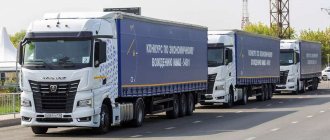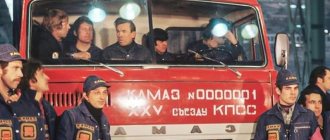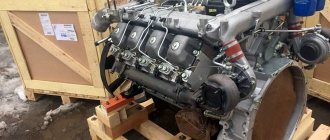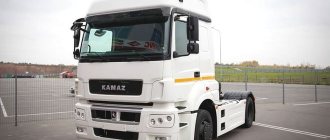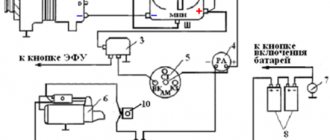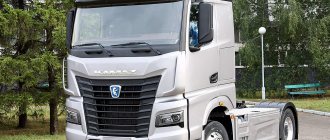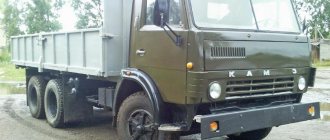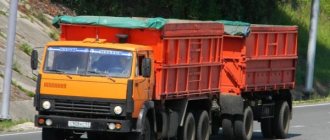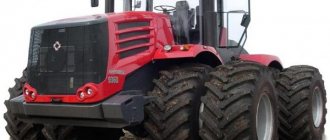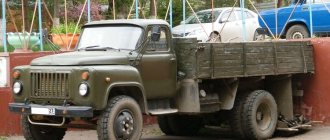“Well, are there any gopniks in Chelny?” — we jokingly ask the driver meeting Reedus journalists at the Nizhnekamsk airport. He laughs: “They’ve been gone for a long time, they’re all gone.” But these characters were once famous throughout the country, and for a metropolitan resident who remembers the late 1980s, when he hears the name Naberezhnye Chelny, plaid pants, ridiculous hats and serious massacres of youth groups that regularly visited Moscow on “tours” come to mind "
Fortunately, this page of the city’s history is now a thing of the past. And, as in Soviet times, when Naberezhnye Chelny was talked about in reports dedicated to KamAZ, the city is again being talked about in connection with the automaker’s plans.
However, judging by archival photos, the city has not changed much in appearance. For a resident of a city that is more than a hundred years old, the view of Naberezhnye Chelny is very unusual. And not only because there is no mud-salt bath on the roads, which is familiar to Muscovites or St. Petersburg residents, and there is compacted white snow on the sidewalks. It's about Soviet architecture: all the way from the airport I caught myself thinking that I was driving through some metropolitan area like Chertanovo or Biryulyovo and waiting for the center with historical buildings to begin.
Naberezhnye Chelny welcomes Reedus journalists
© Sergey Domuschiy/Ridus
"To the foundry"
I am sure that if we had spent more time at KamAZ, we would have left with a whole dictionary of special factory vocabulary and a collection of historical anecdotes, countless of which are preserved in the memory of the head of the factory museum, Alexander Chukhontsev.
And I especially remember that here for some reason they don’t say “at the foundry”, but use the phrase “at the foundry”: “go to the foundry”, “work at the foundry”. It sounds somehow more solid. And, as it turns out, it’s not just the sound.
KAMAZ
© Sergey Domuschiy/Ridus
The briefing before entering the workshop included the obligatory “do not touch with your hands”, “do not leave the yellow lines”, but the warnings were clearly unnecessary. When you are standing in the middle of all this roar and flame, you don’t want to deviate from the route at all. I remembered the famous one from Zhvanetsky:
“Among us, there is a high incidence of trauma due to mechanization, especially in the foundry. How many of our people could not jump over that stream! They reached the middle and disappeared to hell.”
“The Stream” is truly impressive.
Foundry
© Sergey Domuschiy/Ridus
But, moving a little away from the ambience in the style of Doom-3 decorations, you begin to understand that this is a completely modern production facility, built using the latest technology in the world.
Foundry
© Sergey Domuschiy/Ridus
And in fact, it has always been like this.
Thanks Comrade Nixon
The example and history of KamAZ could serve as an excellent illustration of how much better peace and cooperation with the United States and Europe are for our country than confrontation.
Foundry production, production of mock-up molds
© Sergey Domuschiy/Ridus
Like the construction of most enterprises in the USSR during the era of industrialization, the appearance of the auto giant on the Kama River would have been impossible without cooperation with the West. The KamAZ foundry project was created by the American company Swindell Dressler, which was then one of the industry leaders. The factories she designed were considered the most technically advanced in the world.
Foundry
© Ridus
This tradition continues today. At the beginning of last year, as part of the investment project “Reengineering of Foundry Production,” German specialists installed the first Otto Junker induction crucible furnace on the foundry.
The capacity of each furnace is 50 tons. This is the same amount as the Swindell Dressler arc furnaces, which are now being phased out. The new ovens should, among other things, provide less pollution and greater safety.
Foundry
© Sergey Domuschiy/Ridus
During the four days that we spent inspecting the KamAZ workshops, the entire history of domestic mechanical engineering of the last 50 years seemed to flash before our eyes.
Engine plant
© Ridus
At the engine plant there are modern automated machines made in Germany, measuring equipment interfaced with a computer via Wi-Fi, which instantly sends data on the parts of the assembled engine to the database.
The stamping production uses equipment from the EU and England. But in one of the areas there is a green press with a characteristic rounded design of the 70s and the logo of the Czech Skoda. In another workshop we managed to find a domestic veteran with the Soviet logo “Plant named after. Ordzhonikidze."
Equipment - veteran
© Sergey Domuschiy/Ridus
Cabin assembly
© Sergey Domuschiy/Ridus
The assembly line seems to have come straight out of a picture in the Vremya program, but even here, upon closer examination, just like in many European enterprises, old but resourceful equipment coexists with new machines and equipment.
I saw exactly the same set of old and new at the Mann+Filter plant in Dingolfing, where machines made in West Germany are still in use, or in Castle Bromwich, England, where, it seems, they still work in workshops made from which Spitfires rolled out into World War II.
Kama Automobile Plant KAMAZ
PJSC KAMAZ (Kama Automobile Plant) is a Russian company, a manufacturer of diesel trucks and diesel engines, operating since 1976 (KAMAZ). It also produces buses, tractors, combine harvesters, electrical units, mini thermal power plants and components.
The main production facilities of the plant are located in the industrial zone of Naberezhnye Chelny. Buses are produced in Neftekamsk (Bashkiria).
Today, KAMAZ PJSC is a full-cycle automotive production unit, combining metallurgical, forging, press-frame, mechanical assembly, special mechanical engineering and tool production with all the necessary energy and auxiliary facilities. The technological chain group includes several large automobile production plants. The following enterprises are located on the Naberezhnye Chelny industrial site: a foundry and forging plant, an engine plant (ZD), a press-frame plant (PRZ), an automobile plant (AvZ), a repair and tool plant (RIZ), and the Master industrial park. The largest of the subsidiaries outside the city of Naberezhnye Chelny: OJSC Neftekamsk Automobile Plant and OJSC Tuymazinsky Concrete Mixer Plant (Republic of Bashkortostan).
By the end of the 2010s, the KAMAZ group of organizations included more than 80 organizations located in Russia, the CIS and abroad.
KAMAZ PJSC has assembly plants in Vietnam, Kazakhstan, Pakistan, and India. The assembly is carried out entirely from components supplied from KAMAZ. Programs are being implemented to localize the production of parts and assemblies from assembly machine kits in the countries where assembly plants are located.
The KAMAZ-master team takes an active part in various rallies held around the world. KAMAZ trucks became winners in the vast majority of the Dakar Rally (formerly Paris-Dakar) 17 times.
The name of the company has changed several times:
in 1969-1973 - it was called “Kama Automobile Plant - Directorate of the Kama Automobile Kama Complex of Plants for the Production of Heavy Duty Vehicles”;
since 1976 - Production Association "KAMAZ".
In August 1990, through the transformation of the KamAZ Production Association of the Ministry of Automotive and Agricultural Engineering of the USSR in accordance with Resolution of the Council of Ministers of the USSR No. 616 of June 25, 1990, KamAZ OJSC was created.
Since 1973, KamAZ has owned the trademarks KamAZ and KAMAZ, and since 1987, the combined trademark KAMAZ with the image of a wild steppe horse (Argamak).
In the company’s documents and advertising materials, the designation “KAMAZ” is not used; Currently, the capitalized version of the name, KAMAZ, is used as a corporate name.
Kingdom of KUKA
Perhaps the most impressive site at KamAZ today is the joint venture plant with the German Daimler, where cabs for the latest generation of KamAZ K5 trucks are assembled.
Assembly line
© Ridus
Cab frame factory
© Ridus
If at the foundry it was possible to reproduce the final scene of the film “Cobra” with Sylvester Stallone, then here everything is more reminiscent of the surroundings from “Minority Report”: a minimum of people, only the giant “arms” of the robots of the German KUKA rise up, pneumatics hiss and “fireworks” periodically flash » from spot welding.
If you don’t see the cabs of the K5 truck crawling along the conveyor, then there are no differences from any Porsche or Audi plant.
From the chronicle of KAMAZ construction
| December 13, 1969 | The first bucket of soil was removed during the construction of the Kama Automobile Plant. |
| Autumn 1970 | The first cubic meters of concrete were laid in the foundation of the first-born KAMAZ - a repair and tool plant, as well as the building of a gray and ductile iron foundry. |
| January 1971 | The first 12-storey residential building in Naberezhnye Chelny was commissioned for KAMAZ pioneers. |
| 1973 | The buildings of almost all the facilities of the first stage of the complex were erected, the first city tram was launched, and the first power unit of the thermal power plant was put under load. |
| May 1974 | The first engine was assembled in the experimental control workshop of the chief designer of KAMAZ. |
| 1975 | At all factories of the complex, installation, commissioning of technological equipment and production of trial products are underway. |
| December 1975 | The first power unit was assembled at the engine plant - using temporary technology, but using its own resources. |
| February 16, 1976 | The first Kama truck rolled off the main assembly line of the automobile plant. The government of the country has approved a general scheme for managing the automotive industry. According to this scheme, KAMAZ received the status of a production association and began to report directly to the USSR Ministry of Automotive Industry, bypassing all central departments. |
| December 29, 1976 | The State Commission headed by the Minister of Automotive Industry of the USSR V.N. Polyakov signed an act on the commissioning of the first stage of the Kama complex of factories for the production of heavy trucks. Already by the time the first stage was put into operation, KAMAZ had huge production assets. They were 2 times higher than at VAZ and 3 times higher than the industry-wide figure for the Ministry of Automotive Industry. |
| October 1977 | KAMAZ completed its first annual plan ahead of schedule, producing 15,000 vehicles. By the end of December there were already 22 thousand. |
| August 1978 | The 50,000th truck has been manufactured. |
| June 1979 | Truck number 100000 rolled off the main assembly line. |
| April 1980 | The 150,000th heavy-duty truck was produced. The growth rate of production at KAMAZ was a record not only for our country. |
| February 1981 | The capacities of the second stage of KAMAZ were put into operation. |
“Oh, I’ll give it a ride!”
Perhaps the most impressive thing during our entire stay at the plant was the test drive day of the KamAZ bestseller - the latest generation K5 truck.
“The process of creating such a machine required huge investments and the involvement of foreign partners. KamAZ will have to fight for its margin. A tough competitive struggle is coming with the market cleared of Chinese expansion,” wrote colleagues from Gruzovik-Press.
When the car was just introduced to the market, KamAZ General Director Sergei Kogogin directly stated that with the K5 they are moving into the premium segment, where a combination of high technical characteristics and options within one model is necessary, and that it is with the K5 that KamAZ will displace the Chinese from the CIS market .
From the further history of the enterprise
| February 1983 | The main event of this year was the creation of a production facility, the main task of which was to provide all KamAZ vehicles with warranty service and supply spare parts for them for the entire life of the vehicle. By the end of the decade, it included 210 auto centers. A developed network of auto centers throughout the vast territory of the USSR, as well as abroad, immediately brought KAMAZ closer to the consumer, made it possible to quickly respond to customer requirements, effectively conduct marketing research, and carry out vehicle repairs and supply of spare parts as quickly as possible. Currently, KAMAZ auto centers are also turning into actively operating dealership centers for the sale of cars and spare parts. |
| 1986 | KAMAZ vehicles, which then made up a quarter of the country's truck fleet engaged in harvesting, transported 60 percent of the 1986 harvest. |
| 1987 | The production of minicars "Oka" was created. On December 21 of the same year, the first Kama minicar “Oka-VAZ-1111” rolled off the assembly line. In 1994, the Oka minicar plant was put into operation, designed to produce 75,000 cars per year. In 2005, ZMA became part of the Severstal-Auto group. |
| 1988 | According to experts, since the start of production of KAMAZ vehicles, the country has received about 8 billion rubles from their operation. transport profit. Thus, already in the first ten years of operation, KAMAZ fully justified all state investments associated with its construction. |
| June 25, 1990 | The government decided to create the KAMAZ joint-stock company on the basis of the property of the production association. KAMAZ became the first of the country's largest enterprises to enter the era of new economic relations. The charter of the KAMAZ joint stock company was approved at the general meeting on August 11, 1990, and the Company was registered on August 23 of the same year. |
| April 14, 1993 | A fire broke out at the engine plant, which in a matter of minutes engulfed the entire enterprise, almost completely destroying not only the production building itself, but also the most complex technological equipment. From the very first days of eliminating the consequences of the fire, work went in two directions - restoring the capacity to produce 100 thousand engines and, in parallel, creating the production of power units based on the latest technological equipment. In an unprecedentedly short time, thanks to the support of the government of Russia and Tatarstan, KAMAZ workers managed to literally restore the enterprise from the ashes. Already in December 1993, the engine plant produced its first products after the fire. |
| In January 2008 | The 1.9 millionth heavy truck was produced. |
| In December 2008 | The German concern Daimler AG acquired 10% of the authorized capital of KAMAZ OJSC. In 2010, Daimler increased its stake in the Russian truck manufacturer to 11 percent. At the same time as Daimler, four percent of KAMAZ securities were purchased by the European Bank for Reconstruction and Development. |
